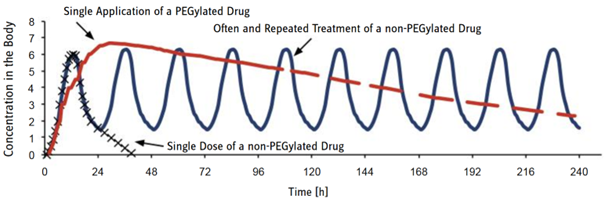Welcome to Iris Biotech
For better service please confirm your country and language we detected.

For better service please confirm your country and language we detected.

Thank you very much for your interest in our products. All prices listed on our website are ex-works, Germany, and may attract customs duties when imported.
You may/will be contacted by the shipping company for additional documentation that may be required by the US Customs for clearance.
We offer you the convenience of buying through a local partner, Peptide Solutions LLC who can import the shipment as well as prepay the customs duties and brokerage on your behalf and provide the convenience of a domestic sale.
Continue to Iris Biotech GmbHSend request to US distributorPublished on 03.05.2022

The big advantage of proteins, antibodies, siRNA, and other natural products in their usage as drugs is their high specificity in combination with their low side effects. They normally interact with the dedicated target only, and thus do not have activities at any other place in the body. Modern biopharmaceuticals are ideal drugs, however, their significant drawback is their low stability under physiological conditions. Due to the fact that they are similar to biological components, they are easily attacked by the immune system of the body, i.e. by antibodies and proteolytic degradation enzymes. Many efforts have been made by highly sophisticated formulation techniques, special application methods (depots) and chemical modification to improve their pharmacokinetic properties.
Novel drug delivery systems are constantly developed and sought after in order to alter the physicochemical and pharmacokinetic properties of drug molecules and to deliver them effectively in a controlled manner. By tuning formulations and thus a drug’s “delivery properties”, ideal results for a drug and a certain application can be achieved and its full potential can be developed.
At Iris Biotech, we are offering various technologies to deliver pharmaceutical ingredients. Most frequently reported in literature are polyethylene glycols (PEG) as well as poly(amino acid)s.
PEGs show a spectrum of unique physical and chemical properties, which have been described in literature extensively by the pioneers in PEGylation: Harris, Veronese and Hermanson. PEG derivatives are available from pure, monodisperse, discrete molecules with short chain lengths or even one ethylene oxide unit only, to long polydisperse constructs, both linear and branched.

Pharmacokinetic properties of a PEGylated drug in comparison with a non-PEGylated drug.
➔ Interested in PEGs for drug delivery? Download our brochure or check out our portfolio.
However, in particular the heavily crowded patent landscape for PEGs, their non-biodegradability and the observation of anti-PEG antibodies due to PEG accumulation led to the fact that plenty of new carriers have been developed. Most of them are based on biocompatible poly(amino acid)s. The repeating functional group is an amide bond, just like in any natural peptide and protein. One of the major benefits of poly(amino acid)s is that they are typically cleaved by enzymes into nontoxic substances and are thus biodegradable.
Iris Biotech’ portfolio includes poly(arginine)s, poly(glutamic acid)s, poly(lysine)s, poly(ornithine)s and poly(sarcosine)s.

General chemical structures of poly(amino acid)s available at Iris Biotech.
➔ Interested? Read our blogposts on poly(sarcosine)s for PEG replacement as well as lipidated poly(amino acid)s for successful RNA delivery.
Besides, we can offer block copolymers, e.g. consisting of PEG and a poly(amino acid) as well as poly(2-oxazoline)s. Just as poly(amino acids), POXs are biodegradable and biocompatible and can easily be functionalized.
Benefit from our services! Formulation of multiple bench-scale samples from 1-5 ml and scaling up from 0,2-5 l are available. Formulation services are mainly focused on the support of client-based screening assays and scale up. These services include optimization of key process parameters such as molar ratios, mixing flow rates, concentration, and flow speed.
In addition to those rather “classical” drug delivery systems, Iris Biotech provides fullerenes and fullerenols of different core sizes (C60 vs. C70) which are reported as carbon-based nanocages for the targeted delivery of therapeutic molecules, e.g. for nucleic acid delivery, benefiting from their nonimmunological reactions. In addition, fullerene and its derivatives show high potential in crossing the blood-brain barrier and delivering drugs into the CNS. More infos on fullerenes are available in our blog – read on to find out more.
➔ Looking for a partner? Get in contact and benefit from our experience!
➔ Various functional groups are available; others can be provided based on custom synthesis!
References:
PEGylation, successful approach to drug delivery; F. M. Veronese and G. Pasut; Drug Discovery Today 2005; 10: 1451-1458.https://doi.org/10.1016/S1359-6446(05)03575-0
Poly(ethylene glycol) in Drug Delivery: Pros and Cons as Well as Potential Alternatives; K. Knop, R. Hoogenboom, D. Fischer and U. S. Schubert; Angew Chem. Int. Ed. 2010; 49: 6288-6308. https://doi.org/10.1002/anie.200902672
On the biodegradability of polyethylene glycol, polypeptoids and poly(2-oxazoline)s; J. Ulbricht, R. Jordan, R. Luxenhofer; Biomaterials 2014; 35: 4848-4861. https://doi.org/10.1016/j.biomaterials.2014.02.029.
Medicinal chemistry and pharmacological potential of fullerenes and carbon nanotubes; F. Cataldo and T. Da Ros; Springer Science & Business Media; 2008; 1.
Carbon Nanotechnology; Chapter 7 – Functionalization and application of [60]fullerene; A. Mateo-Alonso, D. Bonifazi, M. Prato; https://doi.org/10.1016/B978-044451855-2/50010-3.
Fullerene-based delivery systems; H. Kazemzadeh, M. Mozafari; Drug Discov. Today 2019; 24: 898-905. https://doi.org/10.1016/j.drudis.2019.01.013
Biological Applications of Fullerenes; A. W. Jensen, S. R. Wilson, D. I. Schuster; Bioorg. Med. Chem. 1996; 4: 767-779. https://doi.org/10.1016/0968.0896(96)00081-8.
Polysarcosine-Functionalized Lipid Nanoparticles for Therapeutic mRNA Delivery; S. Nogueira, A. Schlegel, K. Maxeiner, B. Weber, M. Barz, M. A. Schroer, C. E. Blanchet, D. Svergun, S. Ramishetti, D. Peer, P. Langguth, U. Sahin, H. Haas; ACS Appl. Nano Mater. 2020; 3(11): 10634-10645. https://doi.org/10.1021/acsanm.0c01834.
Factors Influencing in Vivo Disposition of Polymeric Micelles on Multiple Administrations; E. Hara, M. Ueda, A. Makino, I. Hara, E. Ozeki, S. Kimura; ACS Med. Chem. Lett. 2014; 5: 873-877. https://doi.org/10.1021/ml500112u.
Suppressive immune response of poly-(sarcosine) chains in peptide-nanosheets in contrast to polymeric micelles; E. Hara, M. Ueda, C. J. Kim, A. Makino, I. Hara, E. Ozeki, S. Kimura; J. Pept. Sci. 2014; 20: 570-577. https://doi.org/10.1002/psc.2655.
Polysarcosine as an Alternative to PEG for Therapeutic Protein Conjugation; Y. Hu, Y. Hou, H. Wang, H. Lu; Bioconjugate Chem. 2018; 29(7): 2232-2238. https://doi.org/10.1021/acs.bioconjchem.8b00237.
Polysarcosine-containing copolymers: Synthesis, characterization, self-assembly, and applications; A. Birke, J. Ling, M. Barz; Prog. Polym. Sci. 2018; 81: 163-208; https://doi.org/10.1016/j.progpolymsci.2018.01.002.